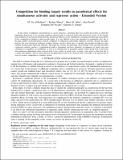| dc.description.abstract | In the context of epigenetic transformations in cancer metastasis, a puzzling effect was recently discovered, in which the elimination (knock-out) of an activating regulatory element leads to increased (rather than decreased) activity of the element being regulated. It has been postulated that this paradoxical behavior can be explained by activating and repressing transcription factors competing for binding to other possible targets. It is very difficult to prove this hypothesis in mammalian cells, due to the large number of potential players and the complexity of endogenous intracellular regulatory networks. Instead, this paper analyzes this issue through an analogous synthetic biology construct which aims to reproduce the paradoxical behavior using standard bacterial gene expression networks. The paper first reviews the motivating cancer biology work, and then describes a proposed synthetic construct. A mathematical model is formulated, and basic properties of uniqueness of steady states and convergence to equilibria are established, as well as an identification of parameter regimes which should lead to observing such paradoxical phenomena (more activator leads to less activity at steady state). A proof is also given to show that this is a steady-state property, and for initial transients the phenomenon will not be observed.
This work adds to the general line of work of resource competition in synthetic circuits. | en_US |
